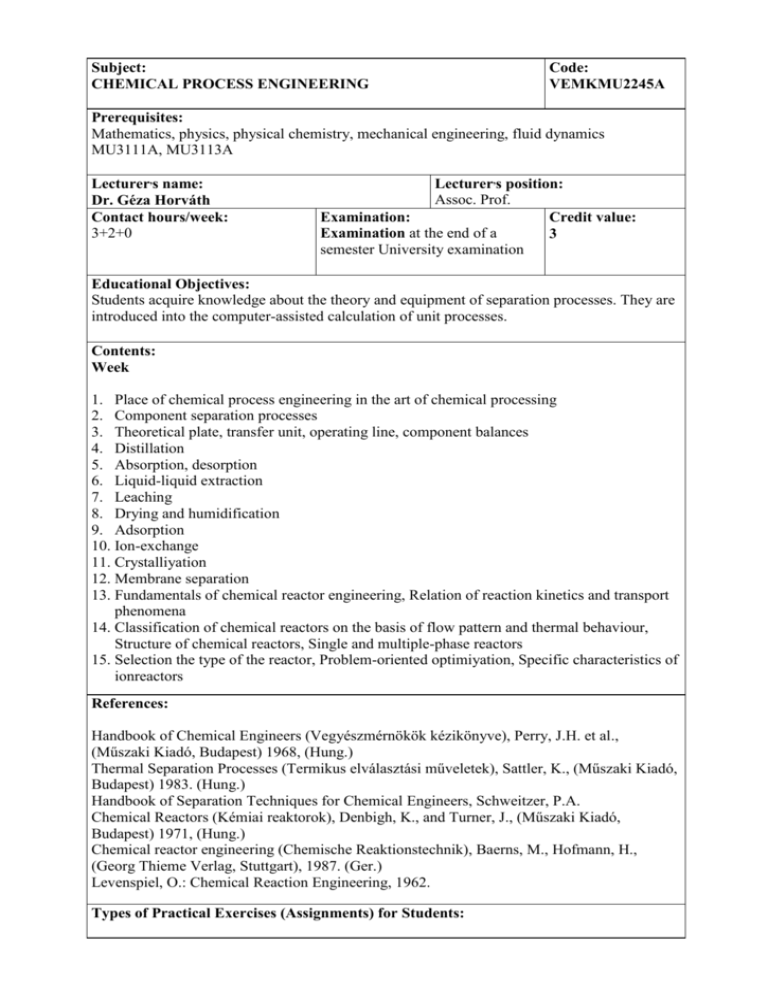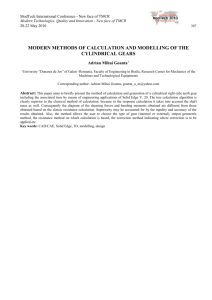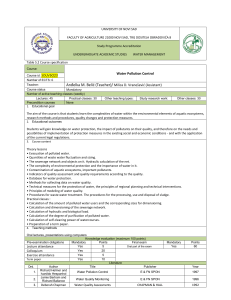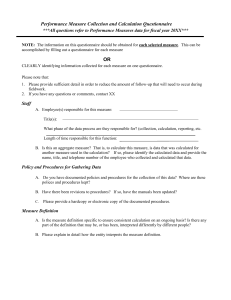chemical process engineering
advertisement

Subject: CHEMICAL PROCESS ENGINEERING Code: VEMKMU2245A Prerequisites: Mathematics, physics, physical chemistry, mechanical engineering, fluid dynamics MU3111A, MU3113A Lecturer,s name: Dr. Géza Horváth Contact hours/week: 3+2+0 Lecturer,s position: Assoc. Prof. Examination: Credit value: Examination at the end of a 3 semester University examination Educational Objectives: Students acquire knowledge about the theory and equipment of separation processes. They are introduced into the computer-assisted calculation of unit processes. Contents: Week 1. Place of chemical process engineering in the art of chemical processing 2. Component separation processes 3. Theoretical plate, transfer unit, operating line, component balances 4. Distillation 5. Absorption, desorption 6. Liquid-liquid extraction 7. Leaching 8. Drying and humidification 9. Adsorption 10. Ion-exchange 11. Crystalliyation 12. Membrane separation 13. Fundamentals of chemical reactor engineering, Relation of reaction kinetics and transport phenomena 14. Classification of chemical reactors on the basis of flow pattern and thermal behaviour, Structure of chemical reactors, Single and multiple-phase reactors 15. Selection the type of the reactor, Problem-oriented optimiyation, Specific characteristics of ionreactors References: Handbook of Chemical Engineers (Vegyészmérnökök kézikönyve), Perry, J.H. et al., (Műszaki Kiadó, Budapest) 1968, (Hung.) Thermal Separation Processes (Termikus elválasztási műveletek), Sattler, K., (Műszaki Kiadó, Budapest) 1983. (Hung.) Handbook of Separation Techniques for Chemical Engineers, Schweitzer, P.A. Chemical Reactors (Kémiai reaktorok), Denbigh, K., and Turner, J., (Műszaki Kiadó, Budapest) 1971, (Hung.) Chemical reactor engineering (Chemische Reaktionstechnik), Baerns, M., Hofmann, H., (Georg Thieme Verlag, Stuttgart), 1987. (Ger.) Levenspiel, O.: Chemical Reaction Engineering, 1962. Types of Practical Exercises (Assignments) for Students: Examination Requirements and Questions: Batch and continuous operation units Component, heat and momentum streams The theory of similitude, dimensionless numbers Component, heat and momentum streams The theory of similitude, dimensionless numbers Component balance for the continuous, two phase, stationary operational units Driving force in case of the continuous, two phase, stationary operational units Batch distillation Continuous rectification, rectification operating line Continuous rectification, stripping operationg line Continous rectification, q-operaficition Minimal, maximal, optimal reflux ratio Fenske equation Determination the number of equilibrium stages Determination the main sizes of rectification Column in case of trays Distillation equipment Calculation of the multicomponent rectification Batch rectification Packings, trays for rectification Special distillation and rectification methods The two-film theory for physical absorption The two-film theory in case of chemisorption Operating lines of absorber-desorber Determination the number of transfer units in case of packed bed column Determination the main sizes of the absorber desorber equipment Liquid-liquid extraction in one theoretical stage Multi-stage liquid-liquid extraction with pure solvent in each stage Multi-stage countercurrent liquid-liquid extraction with reflux The fundamentals of calculation the main sizes of liquid-liquid extraction equipment Solid-liquid extraction and equipment The Ramzin-Mollier diagram of wet air The kinetics of drying Mass balance equations for convective drying Drying equipment The kinetics of adsorption and ion-exchange Frontal adsorption and ion-exchange Adsorption and ion-exchange equipment Pressure swing adsorption Crystallisation and solution Crystallisation equipment Solid membranes, separation equipment Classification of operational units after residence time distribution Average residence time, residence time distribution Classification of the chemical reactors Isotherm, adiabatic and politrope reactors During the semester 2 examination papers under supervision must be written. If the average value of this examinations is below 2, then the student can begin the oral examination only with repeated examination card. During the oral examination, - (two examination topics working out in written form (30 min), after this oral examination about 30 min) - we give a collocvium note. To achieve note 2 the fundamental knowledge of chemical process engineering is necessary. Calculation exercises: 1. 2. 3. 4. 5. 6. 7. 8. 9. 10. 11. 12. 13. 14. 15. Dimension analysis Connective, conductive, transfer streams Two-films-theory, driving-force, work-line, balance Transfer, driving-force, work-line, balance Calculation of distillation processes Calculation of rectification processes Calculation of absorption processes Calculation of liquid-liquid extraktion processes Calculation of liquid-solid extraktion processes Calculation of drying processes Calculation of adsorption processes Calculation of ion-exchange processes Calculation of crystallisation processes Calculation of membrane separation processes Calculation of chemical reactors The calculation exercise practice note is based on the average value of the two examination papers written under supervision, which is modified from fraction to complete note after the work of the student during the semester. If the average value is below 2, then the student must write a new examination paper with repeated examination card. Signatur of Head of Department: Signature of Lecturer:






